The V3 is one of the smoothest scooters money can buy. It is vast on premium features but at an equally premium price.

Our review score is based on thorough real-world testing and is always held up against comparable models.
How We TestValues marked with '*' are based on our independent testing and may differ from those specified by the manufacturer.
After six months and 300 miles of intense testing, I'm ready to reveal my in-depth review and performance results for the Apollo Phantom V3.
The launch of the first Apollo Phantom was a game-changer for me. It was my first experience with a high-end electric scooter, and the memory of that initial ride remains crystal clear.
Fast forward a few years, I have tested over a dozen high-end scooters, but the V1 and V2 remain among the best I have tried.
The 2023 "V3" model came with towering expectations. Let's see if the Phantom line remains relevant in a rapidly growing industry with impressive contenders left and right.
I took the Apollo Phantom V3 through our test process. These are my performance results as a 175 lbs (79 kg) rider.
| Top speed | 41.2 MPH (66.3 KMH) |
| Acceleration 0-15 MPH | Avg: 2.44 seconds Best: 2.31 seconds |
| Acceleration 0-20 MPH | Avg: 3.69 seconds Best: 3.5 seconds |
| Acceleration 0-25 MPH | Avg: 5.42 seconds Best: 4.91 seconds |
| Acceleration 0-30 MPH | Avg: 7.28 seconds Best: 7 seconds |
| Hill climb 250ft @8% | 6.0 s (Avg Speed: 28.4 MPH) |
| Range (speed priority) | 25.9 miles (41.7 km) |
| Range (regular) | 32.4 miles (52.1 km) |
| Range (range priority) | 37.3 miles (60 km) |
| Braking distance 15 MPH - 0 MPH | 9.8 ft (2.99 m) |
| Motor Power | 2 x 52V 1200W motors (2400W) |
| Battery | 52V, 23.4Ah = 1216.8 Wh |
| Weight | 77 lbs (34.9 kg) |
| Max Load | 300 lbs (136.1 kg) |
| Tires | Quadruple spring |
| Brakes | Dual discs + regen |
| Suspension | Quadriple spring |
| Weather Resistance | IP54 |
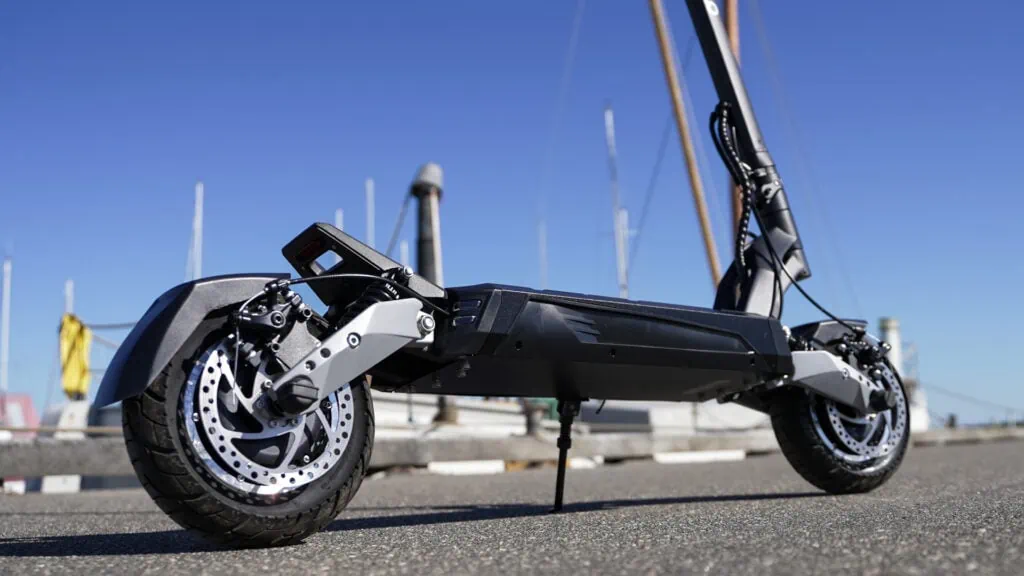
Thanks to the new MACH 1 controller, the Phantom achieves thrilling performance with incredibly smooth power delivery.
The Apollo Phantom V3 boasts dual 52V motors with a nominal power output of 2,400W. It has a stated maximum speed of 41 MPH (66 KMH).
The MACH 1 controller is at the heart of the V3's performance enhancements. According to Apollo, it increases efficiency by 27%, which I felt in acceleration and hill climbing ability. Not only does it pull away faster, but its 25A power delivery is buttery smooth, unlike anything I've ever felt below $2,500.
The upgraded controller now features app integration, allowing you to tailor the Phantom to your liking. You can adjust speed modes, set cruise control, choose between zero/kick start, and fine-tune the acceleration curve to suit your preferences.
I love that the Apollo Phantom V3 can adapt to any rider profile. Whether you want a high-performance adrenaline rush or the comfort and range of a tamed beast at 20 MPH, this versatile scooter can be dialed in to match everyone's needs.
In my tests, I consistently hit a top speed of 41.2 MPH (66.3 KMH). This is a tad less than what I achieved with the V1 but still more than what Apollo states.
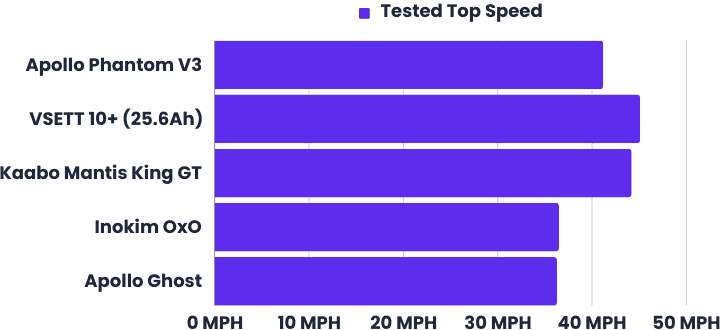
| Model | Top Speed | $/Speed |
|---|---|---|
| Apollo Phantom V3 $2199 USD | 41.2 MPH (66.3 KMH) | $53.37/MPH |
| VSETT 10+ (25.6Ah) $1790.99 USD | 45.1 MPH (72.6 KMH) | $39.71/MPH |
| Kaabo Mantis King GT $1899 USD | MPH (0 KMH) | $INF/MPH |
| Inokim OxO $1399 USD | 36.5 MPH (58.7 KMH) | $38.33/MPH |
| Apollo Ghost | 36.3 MPH (58.4 KMH) | - |
The Apollo Phantom positions itself in the middle of its class. It is one of the more expensive models relative to top speed, but it is a notable step up from the Apollo Ghost and Inokim OxO.
Limited by its 52V, it can't quite keep up with the VSETT 10+ and Mantis King GT, which operate at 60V. Still, it is a hauntingly fast ride with more than enough power to satisfy speed fanatics.
The V3 is far superior in acceleration performance from its predecessors. In my tests, it roughly accelerates 11% faster than the V2. This improvement can be attributed to the more efficient MACH 1 controller.
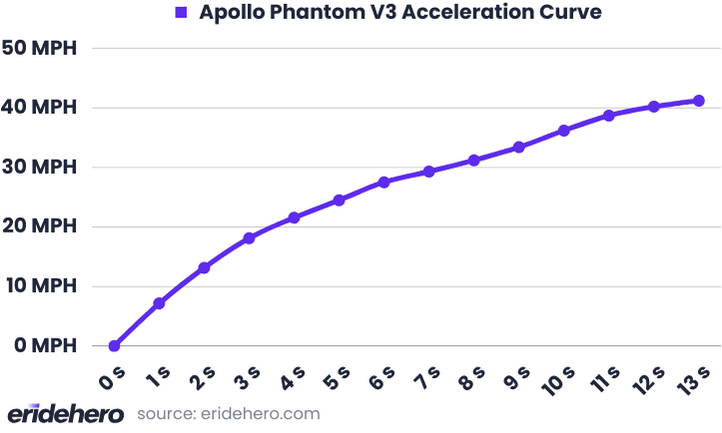
| Interval | Average | Best |
|---|---|---|
| 0-15 MPH (24 KMH) | 2.44 s | 2.31 s |
| 0-20 MPH (32.2 KMH) | 3.69 s | 3.5 s |
| 0-25 MPH (40.2 KMH) | 5.42 s | 4.91 s |
| 0-30 MPH (48.2 KMH) | 7.28 s | 7 s |
| 0-41.2 MPH (66.3 KMH) | 12.9 s | 12.1 s |
The Phantom packs a punch, and the power delivery is incredibly smooth. High-power scooters tend to feel jumpy when operating the throttle at lower speeds (I am talking about you, Dualtron).
This births a bad habit of pressing the throttle in split-second bursts. It makes for an uncomfortable ride, but it is also inefficient and can be unsafe at times.
Thanks to an incredibly smooth low-latency throttle with minimal dead space and tactile feedback, however, that isn't the case on the Apollo Phantom V3. Finessing the throttle is as intuitive as anything.
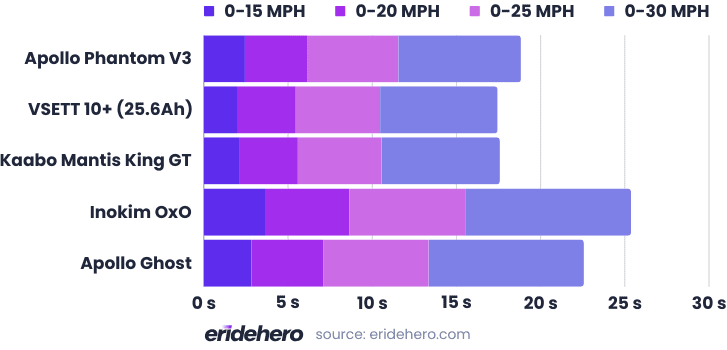
| Model | 0-15 MPH | 0-20 MPH | 0-25 MPH | 0-30 MPH |
|---|---|---|---|---|
| Apollo Phantom V3 | 2.44 s | 3.69 s | 5.42 s | 7.28 s |
| VSETT 10+ (25.6Ah) | 2.02 s | 3.44 s | 5.01 s | 6.98 s |
| Inokim OxO | 3.63 s | 5.01 s | 6.92 s | 9.81 s |
| Apollo Ghost | 2.82 s | 4.3 s | 6.23 s | 9.22 s |
Holding it up against the competition, the Phantom is, once again, vastly superior to the Ghost and OxO. As expected, the 60V systems in the VSETT 10+ and Mantis King GT are about 15% faster off the line.
Hill climbing demands power, and the Apollo Phantom has that in excess.
I put this dual-motor beast to the test on a 250 ft (76 m) incline with an average grade of 8%, and it conquered it in just 6.0 seconds with an average speed of 28.4 MPH (45.7 KMH). While I don't have steeper inclines in my area, I'm pretty confident it can handle up to 25% based on experience and some number-crunching.
| Model | Time | Speed |
|---|---|---|
| Apollo Phantom V3 | 6.0 s | 28.4 MPH (45.7 KMH) |
| VSETT 10+ (25.6Ah) | 5.6 s | 30.4 MPH (49 KMH) |
| Inokim OxO | 7.6 s | 22.4 MPH (36.1 KMH) |
| Apollo Ghost | 6.9 s | 24.7 MPH (39.8 KMH) |
When it comes to tackling hills, it's only about 6% slower than the VSETT 10+ and Mantis King GT. It easily outperforms the Ghost with a comfortable lead and leaves the Inokim OxO in the dust with an impressive 23% difference.
The Apollo Phantom V3 is a truly versatile dual-motor electric scooter with enough power to tackle the most demanding challenges. While there are a few contenders that beat it on sheer motor performance, it offers one of the smoothest acceleration curves I've ever tested.
If you want a scooter that is as smooth at 20 MPH as 40 MPH, the Phantom is a great choice. It will handle riders up to 285 lbs (130 kg) on steep inclines and mixed terrain effortlessly, with minimal performance impact. Even for riders nearing the 300 lbs weight limit, it will still deliver impressive performance, albeit with a slight reduction.
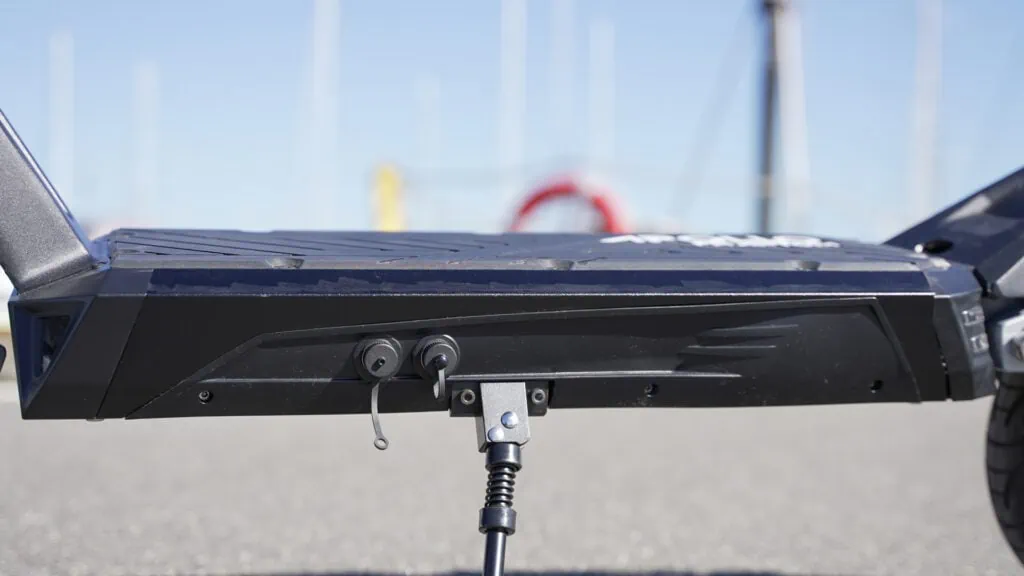
With 32.4 miles of real-world range, the Phantom can go the distance even at high speeds. However, some competitors offer more range at the same price.
This electric scooter sports a 52V, 23.4Ah battery with a 1216.8 Wh capacity. Apollo advertises a max range of 50 miles (80.5 km) under conservative riding conditions.
I was hoping Apollo would introduce 21700 cell technology for its greater energy density, as seen in the City Pro and Pro. However, it still uses the same 126 x 18650 cell structure we saw in the V1 and V2.
It looks like Apollo is sticking to what already works but without much innovation battery-wise. The fact that this scooter has a 52V battery leaves a slight performance gap compared to 60V alternatives.
| Model | Battery Capacity |
|---|---|
| Apollo Phantom V3 | 1216.8 Wh (52V, 23.4Ah) |
| VSETT 10+ (25.6Ah) | 1536 Wh (60V, 25.6Ah) |
| Kaabo Mantis King GT | 1440 Wh (60V, 24Ah) |
| Inokim OxO | 1560 Wh (60V, 26Ah) |
| Apollo Ghost | 946.4 Wh (52V, 18.2Ah) |
The VSETT 10+ (25.6Ah) boasts a 23% higher battery capacity than the Phantom, while the Mantis King GT outclasses it by 17%. The Inokim OxO, with its impressive battery size, seems to provide the best capacity for its price in its category. The Phantom still leaves a welcome gap down to the Ghost, which is also reflected in range.
Regarding battery capacity relative to price, the Phantom is one of the more expensive options in the high-end scooter class.
Battery capacity, cell technology, and hypothetical numbers don't tell the whole story.
I conducted three range tests at varying speeds to understand the real-world performance of the Apollo Phantom 2023.
| Test (#) | Range | Avg. Speed |
|---|---|---|
| #1: Speed Priority | 25.9 miles 41.7 km | 29.8 MPH 48 KMH |
| #2: Regular | 32.4 miles 52.1 km | 22.3 MPH 35.9 KMH |
| #3: Range Priority | 37.3 miles 60 km | 16.2 MPH 26.1 KMH |
In the first test, focusing on speed and going full throttle, I managed to cover a distance of 25.9 miles (41.7 km).
In the second test, cruising at a more comfortable pace, I achieved the most accurate real-world result, with a range of 32.4 miles (52.1 km).
In the last test, where I aimed to maximize range by riding slowly and relying heavily on regenerative brakes, I achieved 37.3 miles (60 km) of range.
All tests were done in the fastest speed mode to establish a comparable basis for the results. In tests #2 and #3, I capped the top speed.
I conducted the same range of tests on all of the competitors. These are my results.
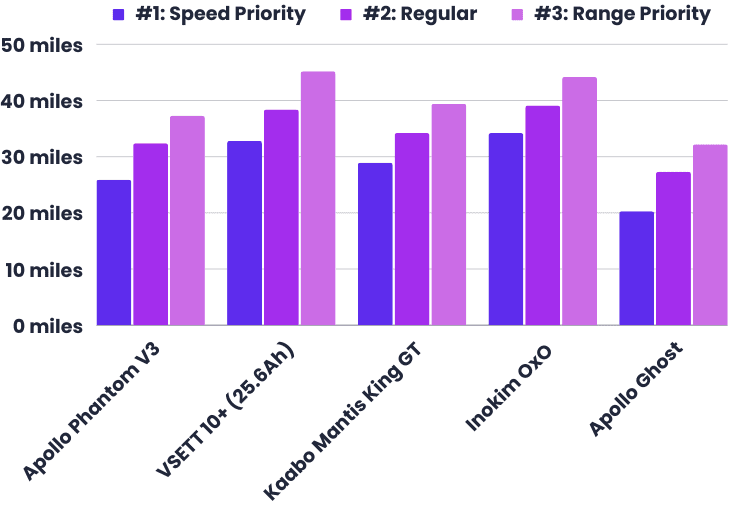
| Model | Range | Avg. Speed |
|---|---|---|
| Apollo Phantom V3 | 25.9 miles (41.7 km) | 29.8 MPH (48 KMH) |
| VSETT 10+ (25.6Ah) | 32.8 miles (52.8 km) | 30.3 MPH (48.8 KMH) |
| Kaabo Mantis King GT | - | - |
| Inokim OxO | 34.2 miles (55 km) | 27.1 MPH (43.6 KMH) |
| Apollo Ghost | 20.3 miles (32.7 km) | 27.6 MPH (44.4 KMH) |
Expectedly, the Phantom falls behind the higher-capacity competitors. However, quite surprisingly, it's only 3 miles behind the Mantis King GT (which even has 21700 cells). This hints at good ride efficiency and battery quality.
| Model | Range | Avg. Speed |
|---|---|---|
| Apollo Phantom V3 | 32.4 miles (52.1 km) | 22.3 MPH (35.9 KMH) |
| VSETT 10+ (25.6Ah) | 38.4 miles (61.8 km) | 21.9 MPH (35.2 KMH) |
| Kaabo Mantis King GT | - | - |
| Inokim OxO | 39.11 miles (62.9 km) | 20.9 MPH (33.6 KMH) |
| Apollo Ghost | 27.3 miles (43.9 km) | 21.1 MPH (34 KMH) |
The Apollo Phantom edges closer to the Mantis King GT in the regular range test. This indicates the Mantis may be slightly more efficient at high speeds.
| Model | Range | Avg. Speed |
|---|---|---|
| Apollo Phantom V3 | 37.3 miles (60 km) | 16.2 MPH (26.1 KMH) |
| VSETT 10+ (25.6Ah) | 45.2 miles (72.7 km) | 16.8 MPH (27 KMH) |
| Kaabo Mantis King GT | - | - |
| Inokim OxO | 44.21 miles (71.1 km) | 15.72 MPH (25.3 KMH) |
| Apollo Ghost | 32.2 miles (51.8 km) | 14.6 MPH (23.5 KMH) |
The range priority test closely mirrors the results of test #2. In comparison, the VSETT 10+ (25.6Ah) provides approximately 19% more range, while the Inokim OxO offers a 17% increase in range.
Like its competitors, the Phantom is a heavyweight. But how does it fare in terms of range relative to weight?
| Model | Range | Weight | Ratio |
|---|---|---|---|
| Apollo Phantom V3 | 32.4 miles | 77 lbs | 0.42 miles/lb |
| VSETT 10+ (25.6Ah) | 38.4 miles | 79 lbs | 0.49 miles/lb |
| Kaabo Mantis King GT | miles | 74 lbs | 0 miles/lb |
| Inokim OxO | 39.11 miles | 74 lbs | 0.53 miles/lb |
| Apollo Ghost | 27.3 miles | 66.1 lbs | 0.41 miles/lb |
With a 0.42 miles per pound ratio, the Phantom is relatively heavy considering its real-world range. While it doesn't lag far behind its competitors, it's worth considering if you prioritize portable performance.

The Phantom 2023 comes with a 58.8V 2A charger and an approximate charging time of 12 hours. This is relatively slow, but with two charging ports, you can cut that time in half by purchasing an extra charger.
You can also purchase Apollo's fast charger to decrease the charging time further, although we recommend limiting charging to 4A to improve the longevity of battery cells.
In comparison, the Mantis King GT has two chargers out of the box for a 6-hour charge cycle. The VSETT 10+ comes with a single 2A charger and takes around 12 hours to fill up, but it also supports dual charging.
The Apollo Phantom V3 stays competitive and has ample real-world range for the vast majority of electric scooter riders.
However, its capacity and real-world range performance are a level below that of the King Mantis GT, Inokim OxO, and VSETT 10+ (25.6Ah). If range relative to price is your deciding factor, the alternatives may match your needs better.
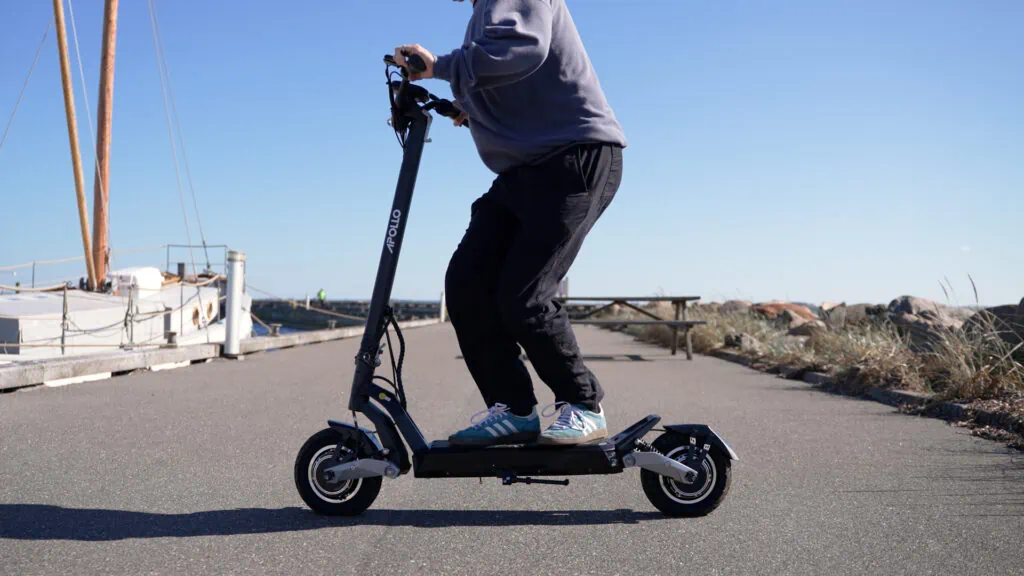
Beefy hybrid tires, quadruple spring suspension, high-performance brakes, and spacious dimensions make the Apollo Phantom a stellar ride.
The Phantom V3 is all about comfort and stability. With a hefty weight limit of 300 lbs (136.1 kg), it's ready to handle riders of any size.
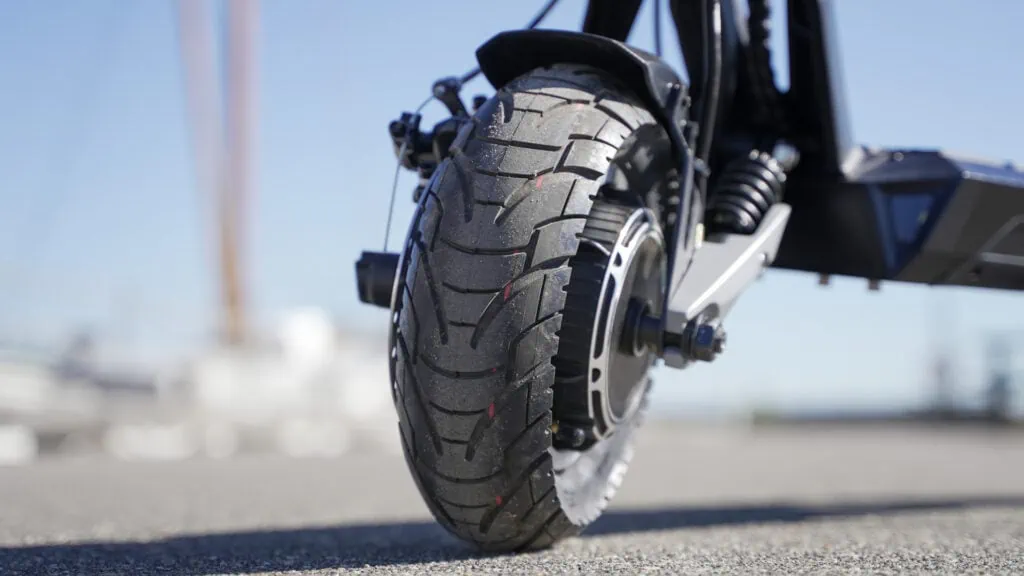
The Apollo Phantom V3 comes equipped with robust 10x3-inch pneumatic stock tires from Touvt (80/65-6). These tires do an excellent job of absorbing shocks alongside the suspension system, and their relatively deep tread enhances versatility on various hybrid road surfaces.
The 65% tire aspect ratio feels just right for the Phantom. It offers exceptionally good handling and responsiveness when cornering without sacrificing comfort. The only negative is that Apollo still uses tubed tires on the Phantom. Hopefully, they go tubeless with the V4.
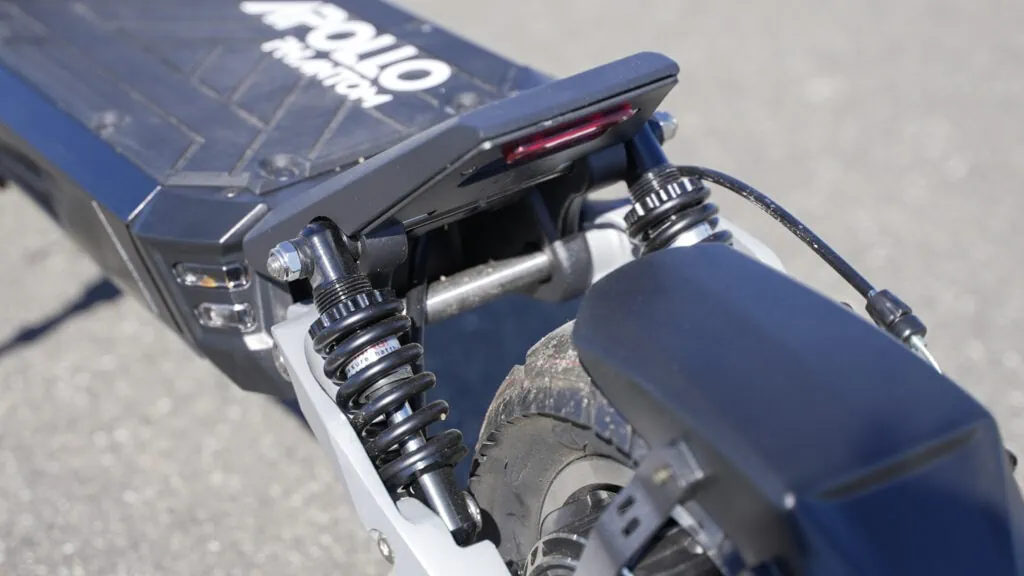
The Apollo Phantom boasts four suspension springs, contributing to an exceptionally smooth ride. While they may not be hydraulic, they effectively keep the rear wheel grounded and reduce road vibrations to perfection.
I love the adjustability of the springs—you can add preload to tailor it to your weight and preferences. Plus, all the springs are easily accessible for quick and efficient adjustments.
I found that increasing the preload slightly at the front while decreasing it at the rear was ideal for my needs, and it only took a few minutes to dial in.
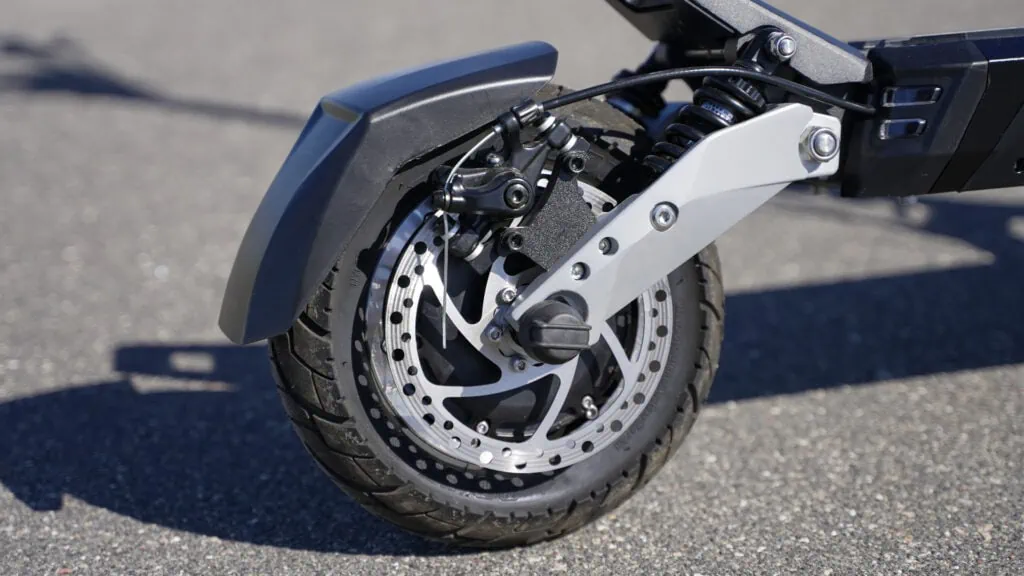
The Phantom has dual 140mm mechanical disc brakes, complemented by Apollo's proprietary regenerative braking system.
While mechanical discs may not offer the same smoothness and performance as hydraulic brakes, the smoothest regen braking I have tested largely makes up for it.
It isn't jolty or abrupt like most other regen brakes in the industry. Instead, it is gradual, smooth, and really easy to operate. You can customize the strength via the app to match your needs.

At high speeds, brake pads wear out quickly. Therefore, I love that the E-ABS is separately controlled. When I''m riding, I almost exclusively use the regen brake and only engage the discs when I need to stop on a dime.
This reduces brake maintenance and enhances range by recuperating kinetic energy and feeding it back into the battery.
I conducted a braking test for this electric scooter, measuring the distance to come to a complete stop from 15 MPH. Across ten runs, I averaged a stopping distance of 9,8 ft (3 m).
For high-performance scooters, anything below 12 feet is considered good, while anything under 10 feet is exceptional.
| Model | Braking Distance |
|---|---|
| Apollo Phantom V3 | 9.8 ft (3 m) |
| VSETT 10+ (25.6Ah) | 9.6 ft (2.9 m) |
| Kaabo Mantis King GT | ft (0 m) |
| Inokim OxO | 9.2 ft (2.8 m) |
| Apollo Ghost | 10.5 ft (3.2 m) |
The Apollo Phantom 2023 is right up there with the best in its class - even though most run hydraulic brakes. We have the ABS to thank for that. The Inokim OxO has the shortest braking distance, but the difference is minuscule.
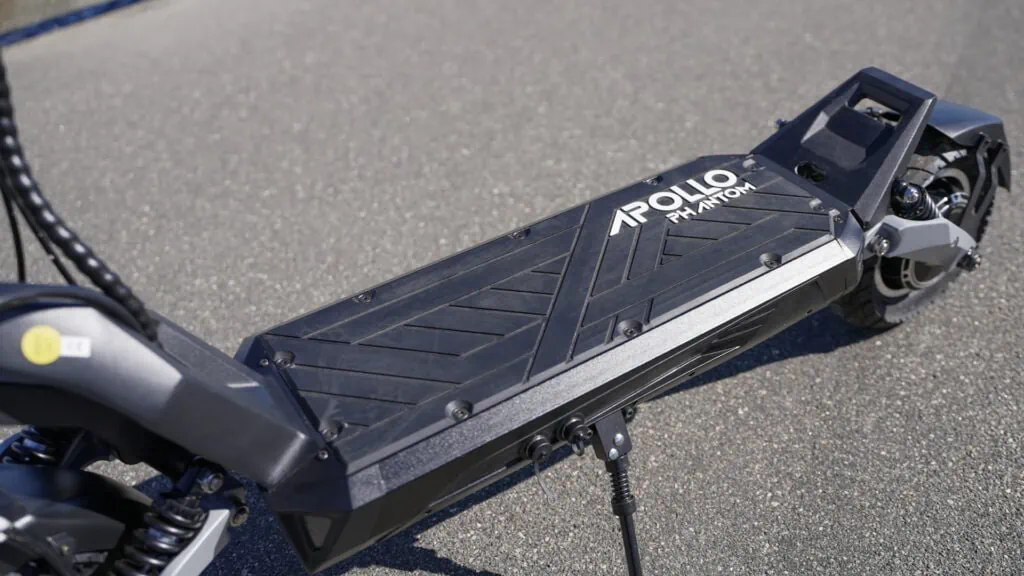
Designed with larger riders in mind, the deck of the scooter measures 20.1" x 7.5" (51.1 cm x 19.1 cm). With a rear footrest, the Phantom becomes a truly versatile scooter, allowing for various standing positions to avoid strain during extended commuting.
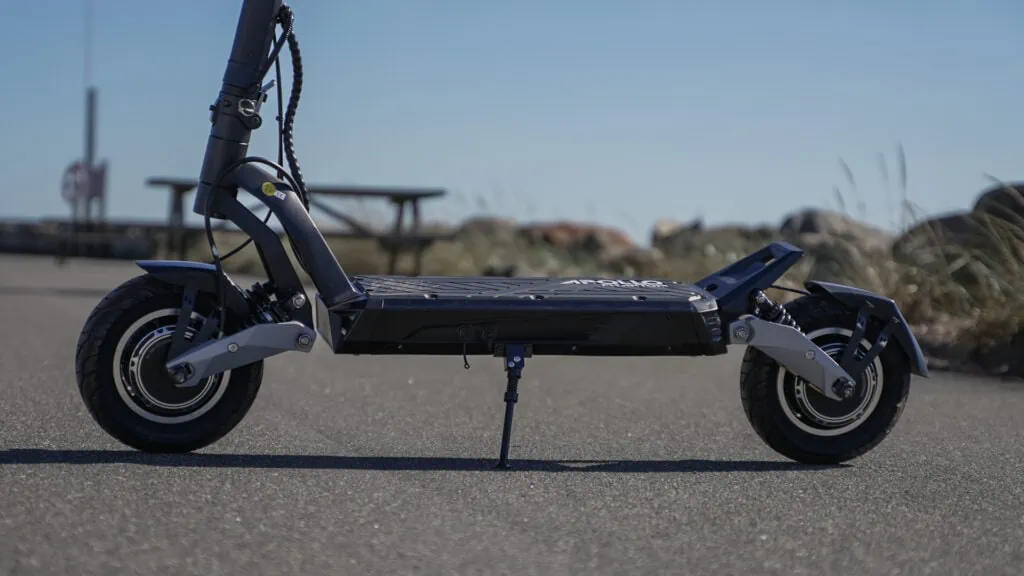
Owing to its tall tires and long swingarms, the Phantom has 6.3" (16 cm) of ground clearance. This is enough to handle curbs and demanding terrain variations comfortably but not excessive to the point where it compromises the scooter's center of gravity.
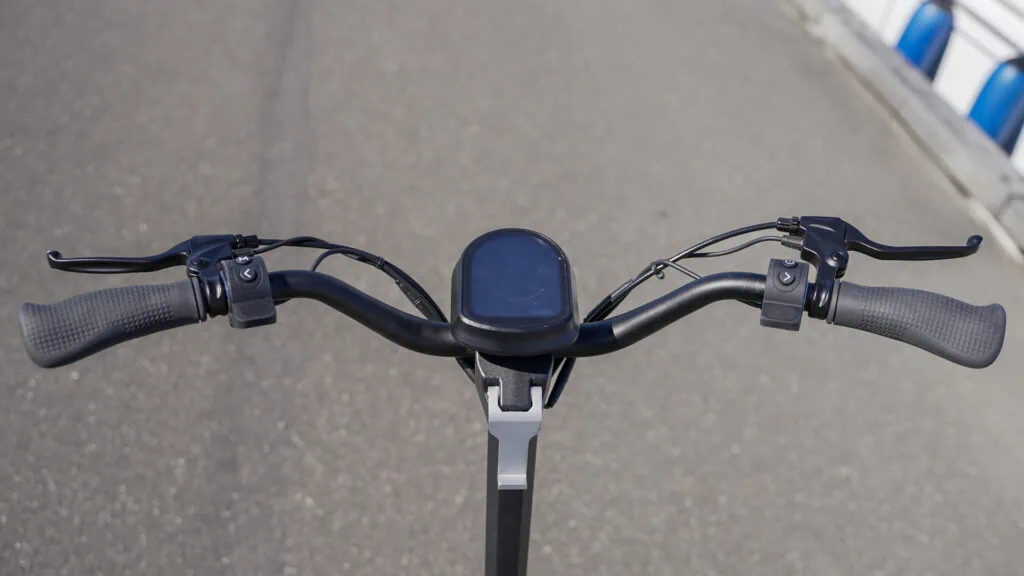
Staying in tune with its sizable nature, the handlebars span 27.6" (70.1 cm) in width. They are angled inward, resembling a bicycle's handlebars, promoting an ideal posture for safety and comfort. This is something I felt the City Pro lacked.
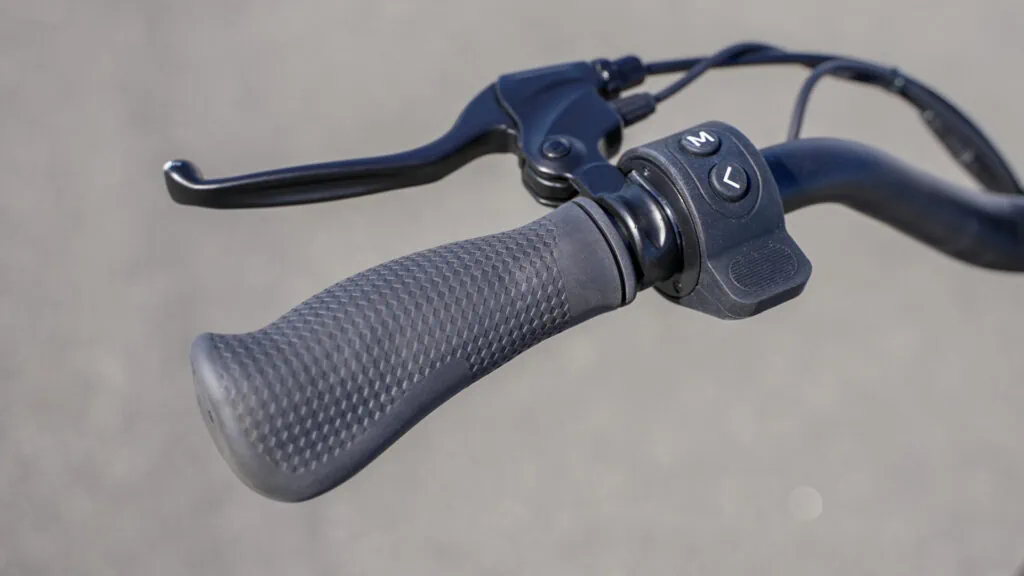
It features chunky, non-slip rubber grips that can be angled to your liking. They have a textured surface and are soft to the touch.
With their ergonomic winged shape, they fit really nicely in my hands. However, they do favor large hands over small hands. Should that be the case for you, it's a cheap and easy change.
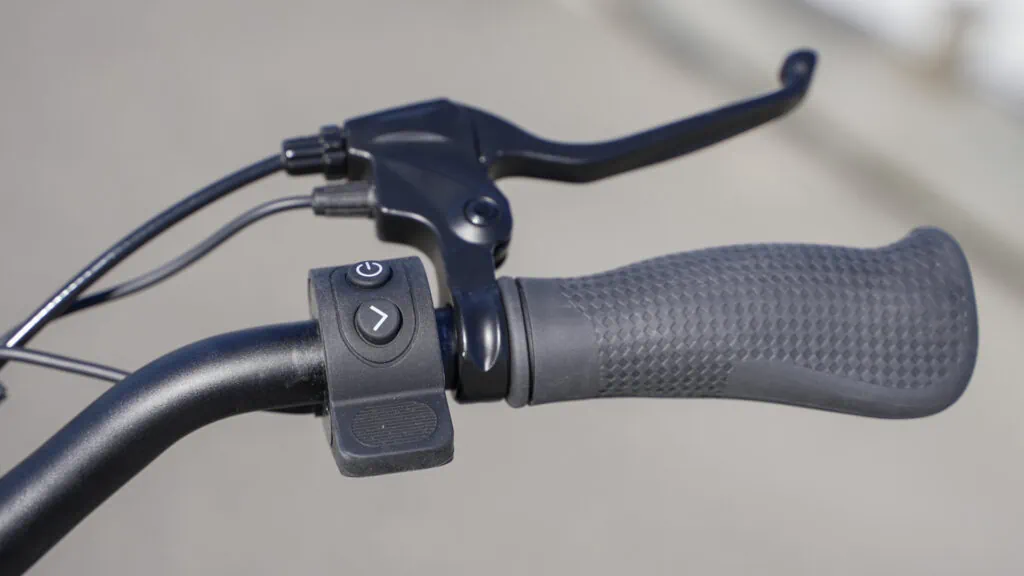
The scooter has a highly comfortable thumb throttle. Although it is a matter of preference, most riders (including myself) prefer thumb throttles over trigger throttles. There is almost no input lag, and there is no dead zone.
The throttle has a textured rubber surface to ensure your thumb doesn't slip, and the two integrated buttons have that addicting tactile feedback I'm looking for.
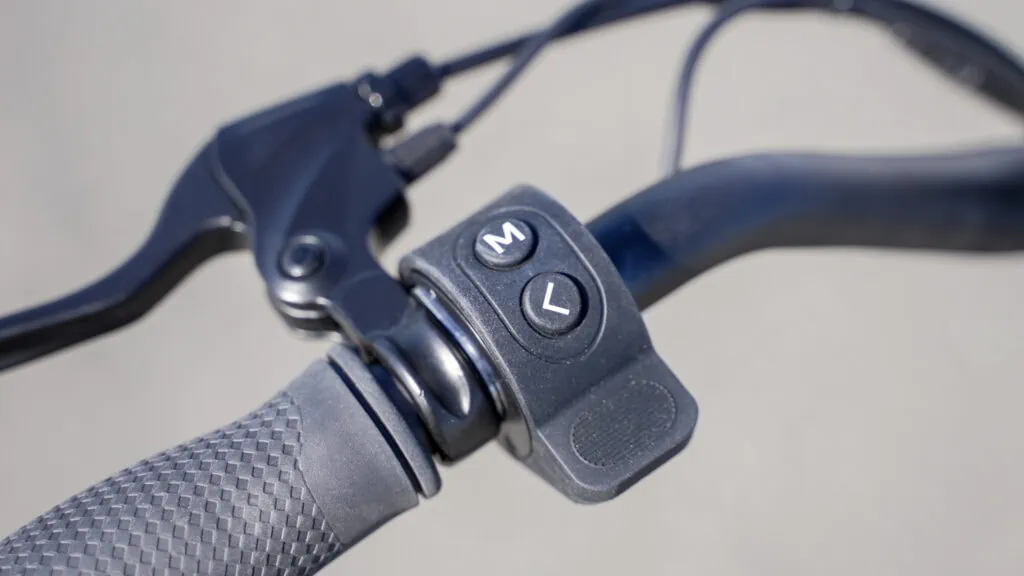
The electronic regenerative brake is found on the left of the handlebar and is identical to the throttle in its operation.
I love that it is separate from the disc brakes. Some scooters integrated both systems for a more seamless riding experience, but for an advanced ride like the Phantom, having the ability to save wear on the discs and pads is a game-changer.

The Phantom has an upgraded LX display that is 2x brighter than its predecessor - but it leaves me wanting more. It is large, and all the essential ride information is neatly arranged for an intuitive overview.
While it is much nicer than the display on the VSETT 10+, I can't help but feel it still lacks brightness in direct sunlight. Also, the anti-glare surface (which is a nice feature, I must admit) scratches easily.
Lastly, I am missing an audible signal in traffic. A basic mechanical bell would be the minimum requirement, but I would have preferred a loud electronic horn for added safety.
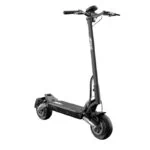
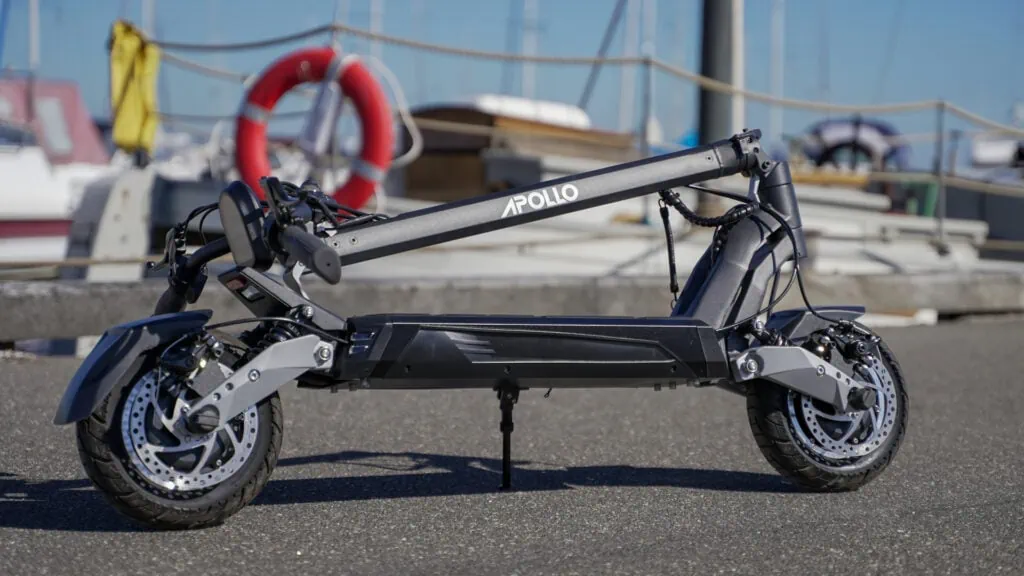
Like other in-class scooters, the Phantom is a heavyweight, but it folds easily and isn't awkward to carry.
The Apollo Phantom 2023 weighs 77 lbs (34.9 kg). You don't buy a high-performance scooter for its portability, but you still want something manageable.
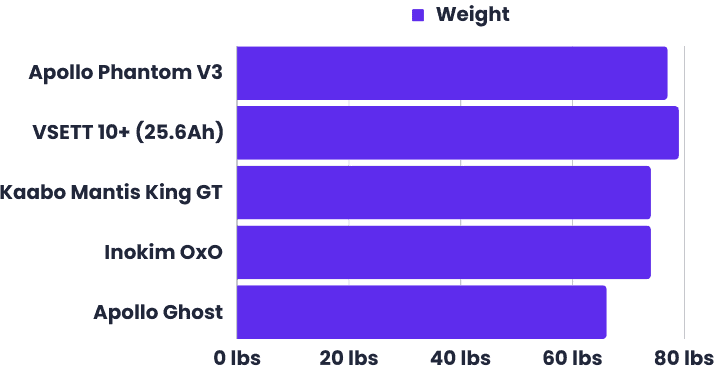
| Model | Weight (lbs) | Weight (kg) |
|---|---|---|
| Apollo Phantom V3 | 77 lbs | 34.9 kg |
| VSETT 10+ (25.6Ah) | 79 lbs | 35.8 kg |
| Kaabo Mantis King GT | 74 lbs | 33.6 kg |
| Inokim OxO | 74 lbs | 33.6 kg |
| Apollo Ghost | 66.1 lbs | 30 kg |
The Phantom weighs 4% more than the Mantis King GT and OxO, but it's 2.5% lighter than the VSETT 10+ (25.6 Ah). These differences are quite minor, and you're unlikely to notice a significant weight variation when carrying them.
You don't want to carry a scooter like this up and down several flights of stairs daily (unless you're Superman). But that goes for any high-end scooter - the Phantom is no different.
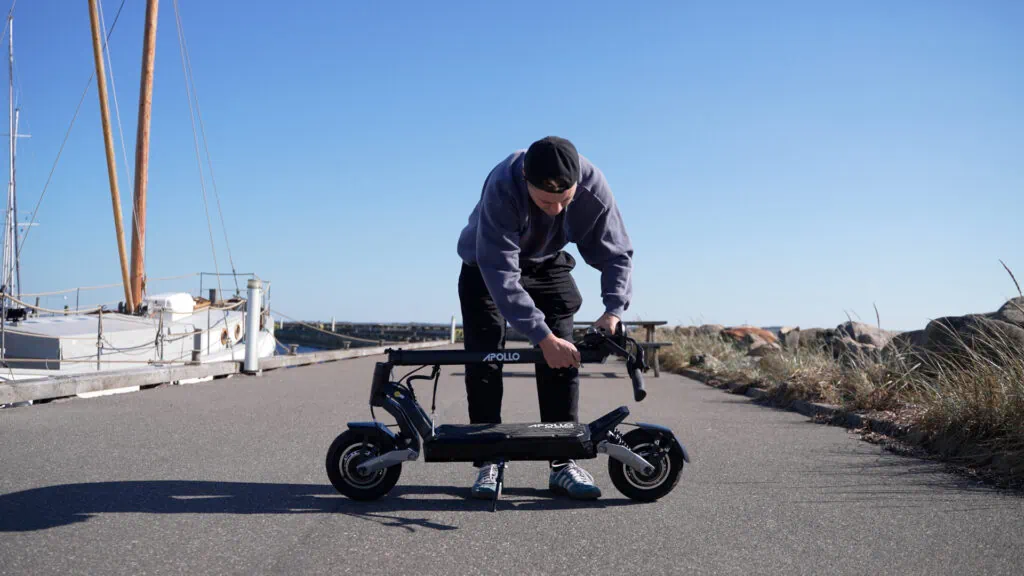
Considering its weight class, the Apollo Phantom does everything right to be as portable as possible.
The folding mechanism is excellent. It is sturdy, doesn't flex, and is easy to operate without excessive force.
A safety pin and ring provide two layers of protection to ensure optimal strength and safety.
A hook located beneath the display links to the rear footrest for carrying. The weight distribution is well-balanced, and the stem is slim enough for a comfortable grip.
Overall, the Phantom is decently portable, considering its monstrous power.

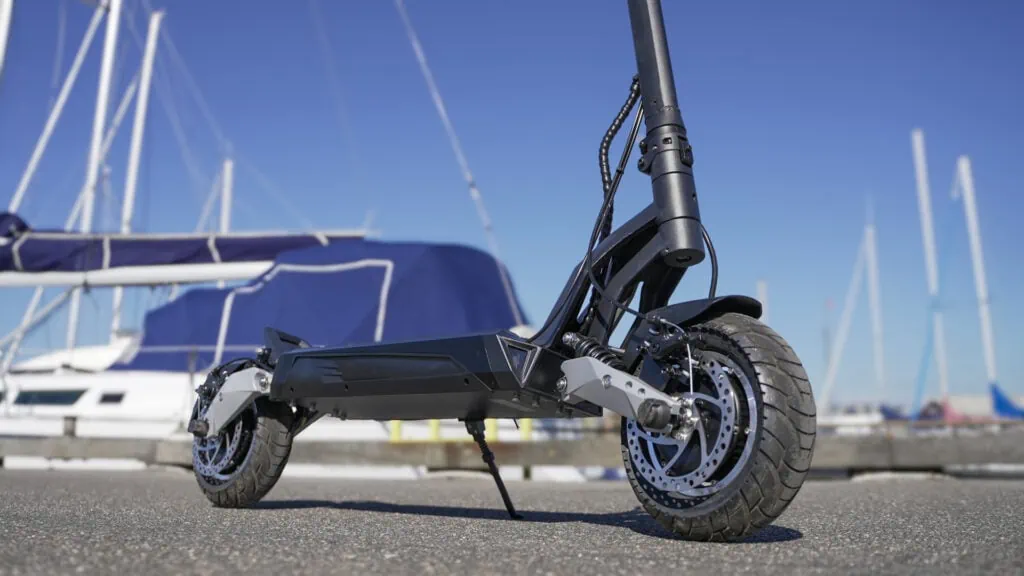
The Phantom sets the bar high with superior construction strength, an impressive 300 lbs weight capacity, and 360° turn signals.
The majority of the build is made from aerospace-grade aluminum alloy. It is a go-to frame material because of its high strength-to-weight ratio, anti-corrosive properties, and heat resistance.
Everything on the scooter feels exceptionally robust, and having seen Apollo's design process, I can confirm that they conduct rigorous stress tests and extensive simulations to guarantee the durability and reliability of their products.
Its high weight capacity and ample motor make the Apollo Phantom one of the top picks for heavy adults.
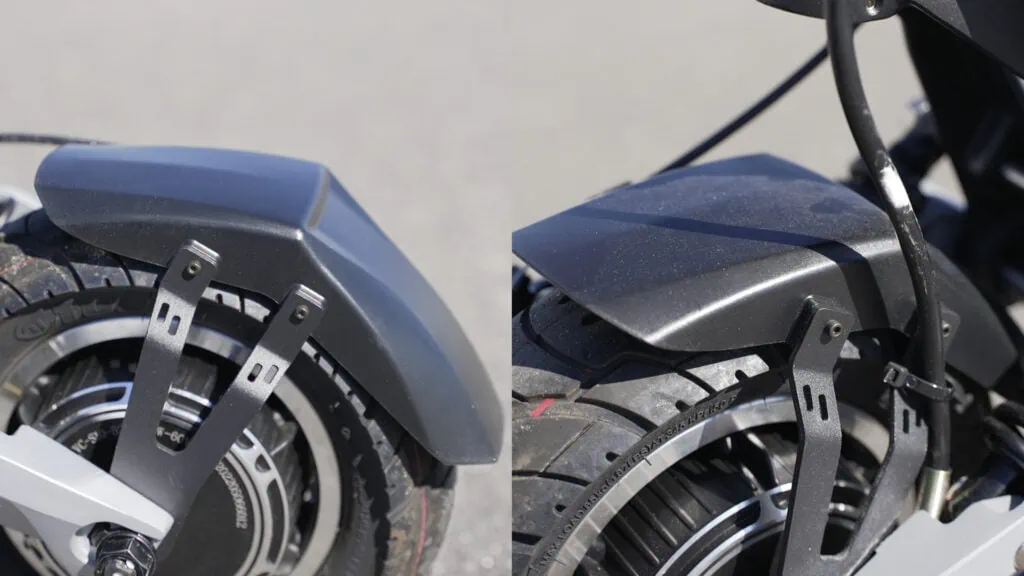
The Phantom's fenders are effectively constructed with good angling to channel water away. While the plastic material is somewhat thin, its angular design compensates by adding structural strength.
I appreciate the choice of having a two-point metal reinforcement on one side of the wheel. This allows for easy access to the disc brakes for adjustments and repairs. However, it does compromise the strength of the fender a bit.

I am a big fan of the folding mechanism on the Phantom. It doesn't flex and is intuitive and quick to fold and lock.
Any folding electric scooter should have at least one extra layer of safety to strengthen the mechanism and ensure it can't be released by accident - The Phantom has two.
A metal rod runs diagonally through the folding mechanism, effectively locking it in place and preventing the scooter from folding. Additionally, a plastic safety ring slides over the folding lever to ensure it cannot be operated.
The folding hook below the LX display and the rear footrest are both made of metal, ensuring solidity and durability throughout the folding system.
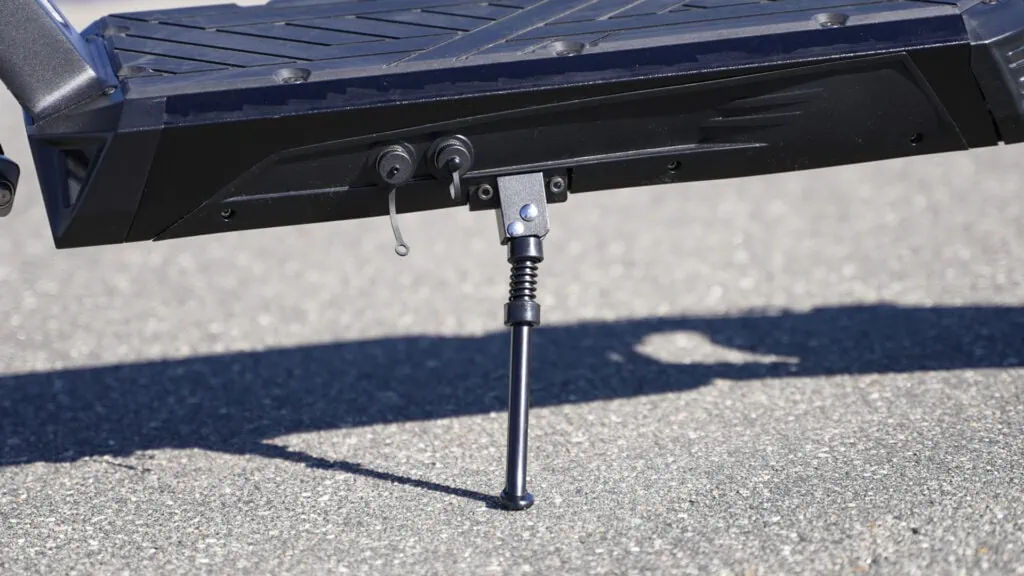
It's refreshing to see that this scooter doesn't cut corners when it comes to its kickstand. The spring-operated design is robust and thoughtfully placed, aligning well with the scooter's weight distribution.
I went through the tedious task of flipping it 500 times to test its longevity. Its performance and stability remained intact, so it is definitely up for the task.
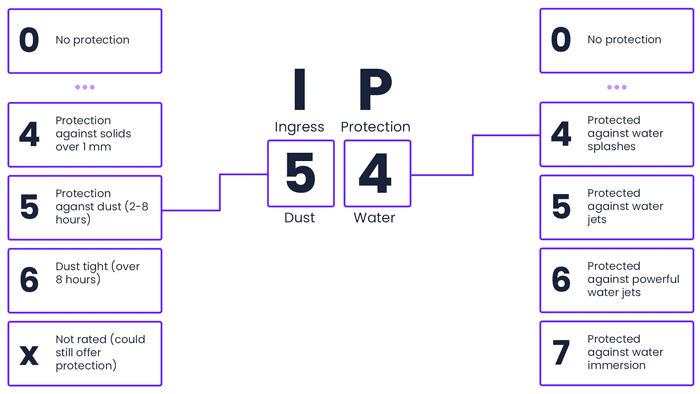
The Apollo Phantom has an IP54 weather resistance rating. This means it is verifiably protected against critical dust ingress for 2-8 hours of continual exposure and water splashes from any direction.
Lab tests are good, but what does this mean in the real world? Its design has no obvious weak points, and the cable openings aren't overly exposed. It should comfortably be able to handle light to moderate rain.
Remember that water damage is not covered under warranty, so ride carefully at your own discretion.

The Phantom V3 electric scooter has an exceptional light setup. It combines turn signals visible from any angle with a bright, high-mounted 1000-lumen headlight and brake light.
The visibility offered by the Apollo V3 is exceptional, and the addition of front turn signals is a significant enhancement. Their convenient throttle integration makes them much easier to use than most competitors.

When I tested the Phantom at night in complete darkness, the high-mounted headlight lit up the road ahead really well, so much so that I was comfortable with going 30 MPH, which I rarely dare after dark.
The only thing I would change is adding a downward angle to the headlight, as its angle could hit the road better.

Thanks to the new intelligent controller, the Phantom V3 has app support for iOS and Android via Bluetooth.
When I first got the Phantom V3, I had issues connecting the app to the scooter on Android. However, Apollo has been swift at work, regularly refining and pushing new updates to their app to address bugs.
What is most important for me is that they're actively working to expand the feature set and user experience, whereas other companies develop a "set-and-forget" app.
Via the Apollo Scooters app, you can customize the Phantom to match your needs. These are the most notable features:
Like all other Apollo scooters, the Phantom is covered with a one-year limited warranty. The frame is also covered for 10,000 kilometers. The warranty only covers new scooters purchased from Apollo directly or from authorized repair centers.
The following parts fall under coverage: Battery, lights, motor, controller, handlebar, display, throttle, folding mechanism, lightbox, headset, IoT, speaker, charger, and scooter frame.
This means general wear and tear items like tires and brakes aren't covered. This is pretty normal as they're regarded as consumables.
One of the things I like in particular is that Apollo has a transparent estimate repair cost overview. As with any scooter warranty, only manufacturer defects are covered. It is not covered if you ride in the rain, misuse it in any way, or crash.
All in all, Apollo offers a pretty favorable warranty on the Phantom V3. Most scooters in this price range offer a standard 12-month warranty, but a few exceptions offer two years of coverage.
The Apollo Phantom V3 is an incredibly capable dual-motor electric scooter with a tested top speed of 41.2 MPH (66.3 KMH) and of real-world range.
It is ideal for riders seeking peak performance in a feature-packed design who don't mind paying a little extra. The Phantom easily climbs steep hills and is incredibly fast off the mark. It goes the distance at speed and can be customized to match your needs.
At 77 lbs (34.9 kg), it isn't a featherweight, but with intelligent design choices and an excellent folding mechanism, it remains one of the more portable scooters in the high-end category.
A few competitors beat it in sheer performance relative to price, but the Phantom sets itself apart with app integration, 360-degree turn signals, and a large LX display.

| Top speed | 41.2 MPH (66.3 KMH) |
| Acceleration 0-15 MPH | Avg: 2.44 seconds Best: 2.31 seconds |
| Acceleration 0-20 MPH | Avg: 3.69 seconds Best: 3.5 seconds |
| Acceleration 0-25 MPH | Avg: 5.42 seconds Best: 4.91 seconds |
| Acceleration 0-30 MPH | Avg: 7.28 seconds Best: 7 seconds |
| Acceleration 0-41.2 MPH | Avg: 12.9 seconds Best: 12.1 seconds |
| Hill climb 250ft @8% | 6.0 s (28.4 MPH) |
| Range (speed priority) | 25.9 miles (41.7 km) |
| Range (regular) | 32.4 miles (52.1 km) |
| Range (range priority) | 37.3 miles (60 km) |
| Braking distance 15 MPH - 0 MPH | 9.8 ft (2.99 m) |
| Handlebar width | 27.6" (70.1 cm) |
| Deck-to-handlebar | 40.5" (103 cm) |
| Unfolded size | 27.6 x 50.8 x 48 in (84.1 x 154.8 x 146.3 cm) |
| Folded size | 27.6 x 20.5 x 48 in (84.1 x 62.5 x 146.3 cm) |
| Ground clearance | 6.3" (16 cm) |
| Deck | 20.1" x 7.5" (51.1 cm x 19.1 cm) |
| Charging time | 12 hours |
| Brand | Apollo |
| Release year | 2023 |
| Top speed | 41 MPH (66 KMH) |
| Motor power (nominal) | 2400W |
| Motor power (max) | Not provided. |
| Motor Voltage | 52V |
| Range | 50 miles (80.5 km) |
| Battery | 52V, 23.4Ah |
| Battery capacity | 1216.8 Wh |
| Charging time | 12 hours |
| IP rating | IP54 |
| Weight | 77 lbs (34.9 kg) |
| Max load | 300 lbs (136.1 kg) |
| Tire type | Tubed, pneumatic |
| Tire size | 10" x 3" |
| Suspension | Quadruple springs |
| Brakes | Dual mechanical disc brakes, regen brake |
| Throttle type | Thumb throttle |
| Lights | Headlight, brake light |
| Additional features | Turn signals, app, adjustable suspension, acceleration adjustment, brake adjustment |